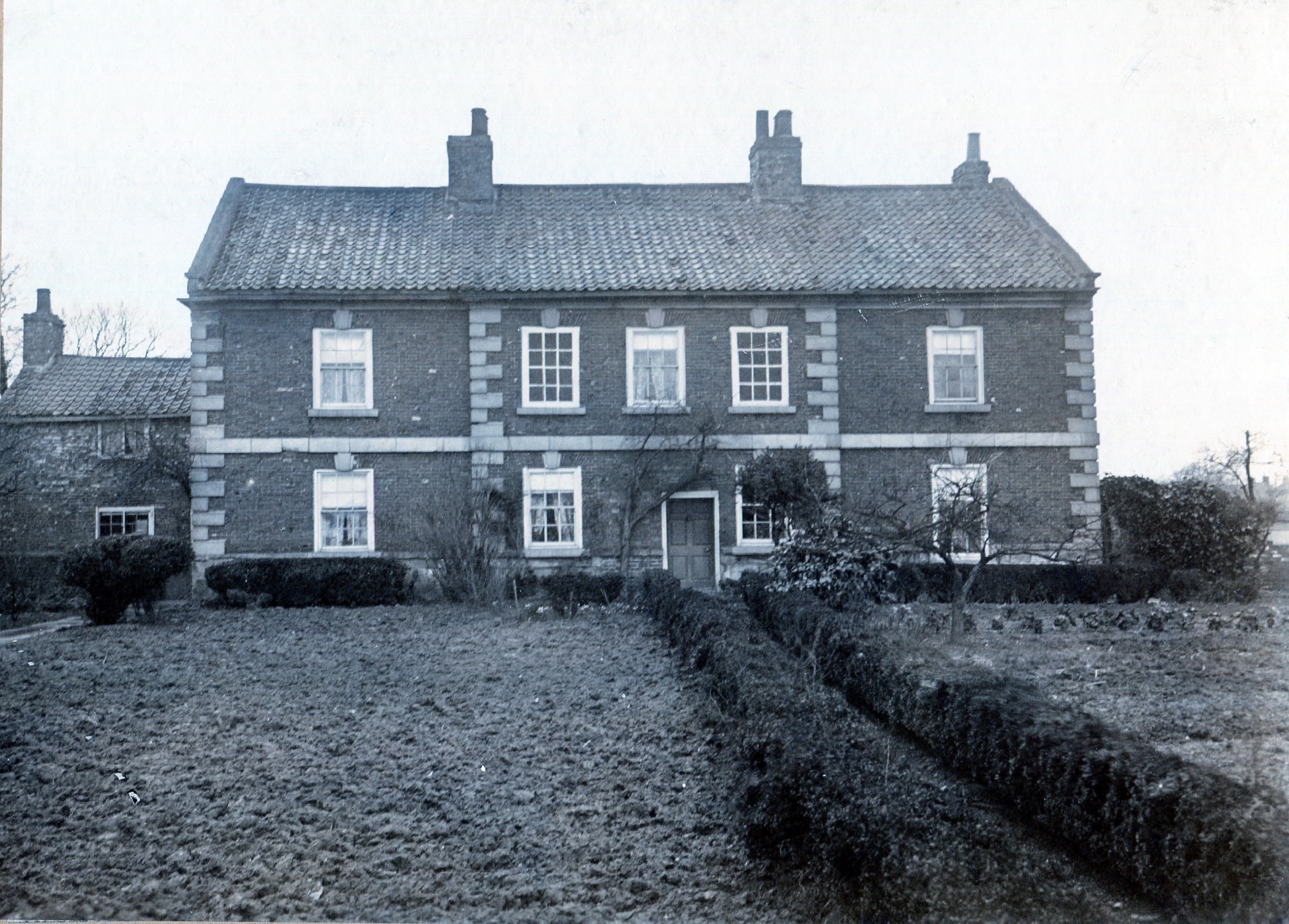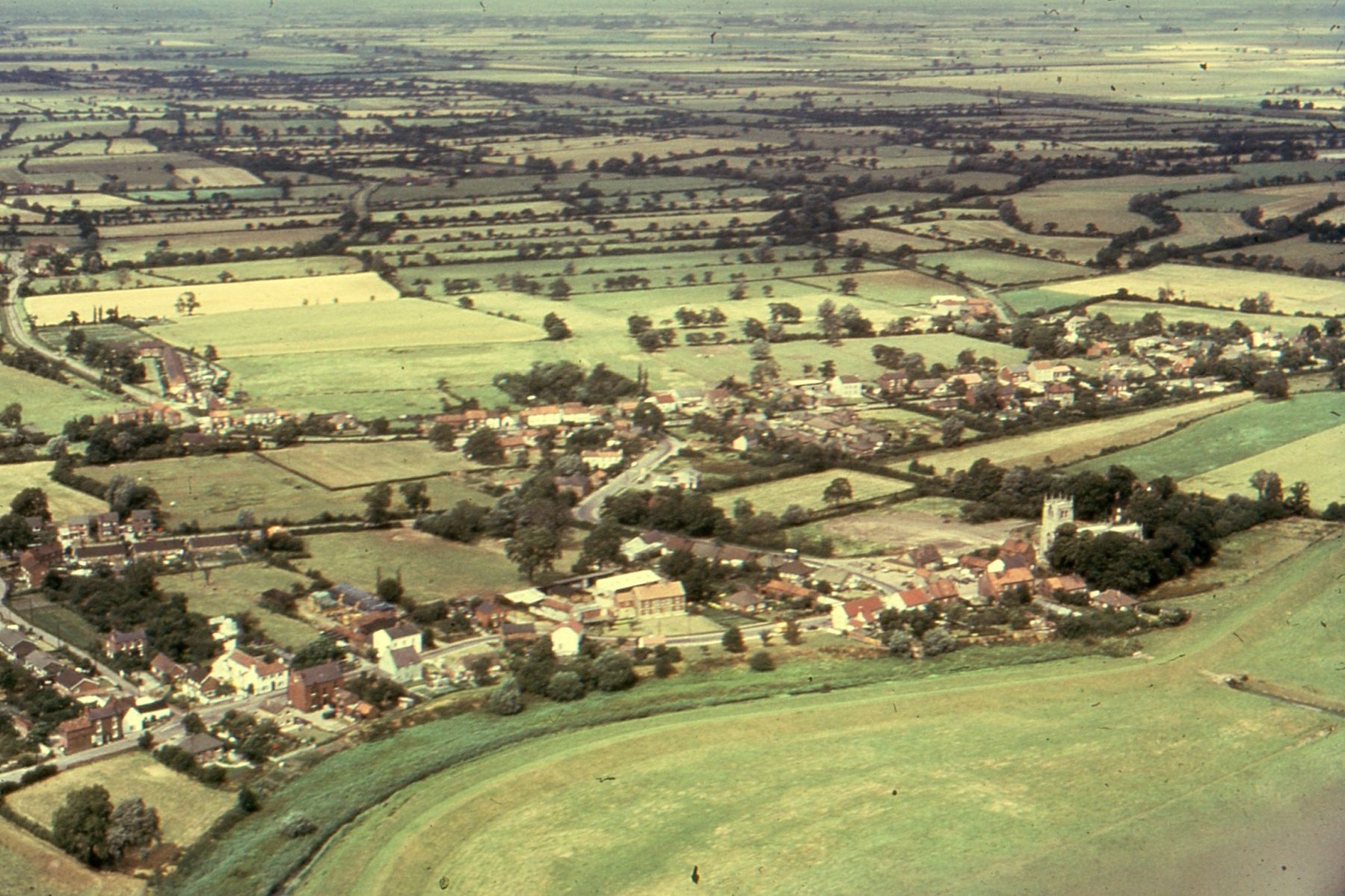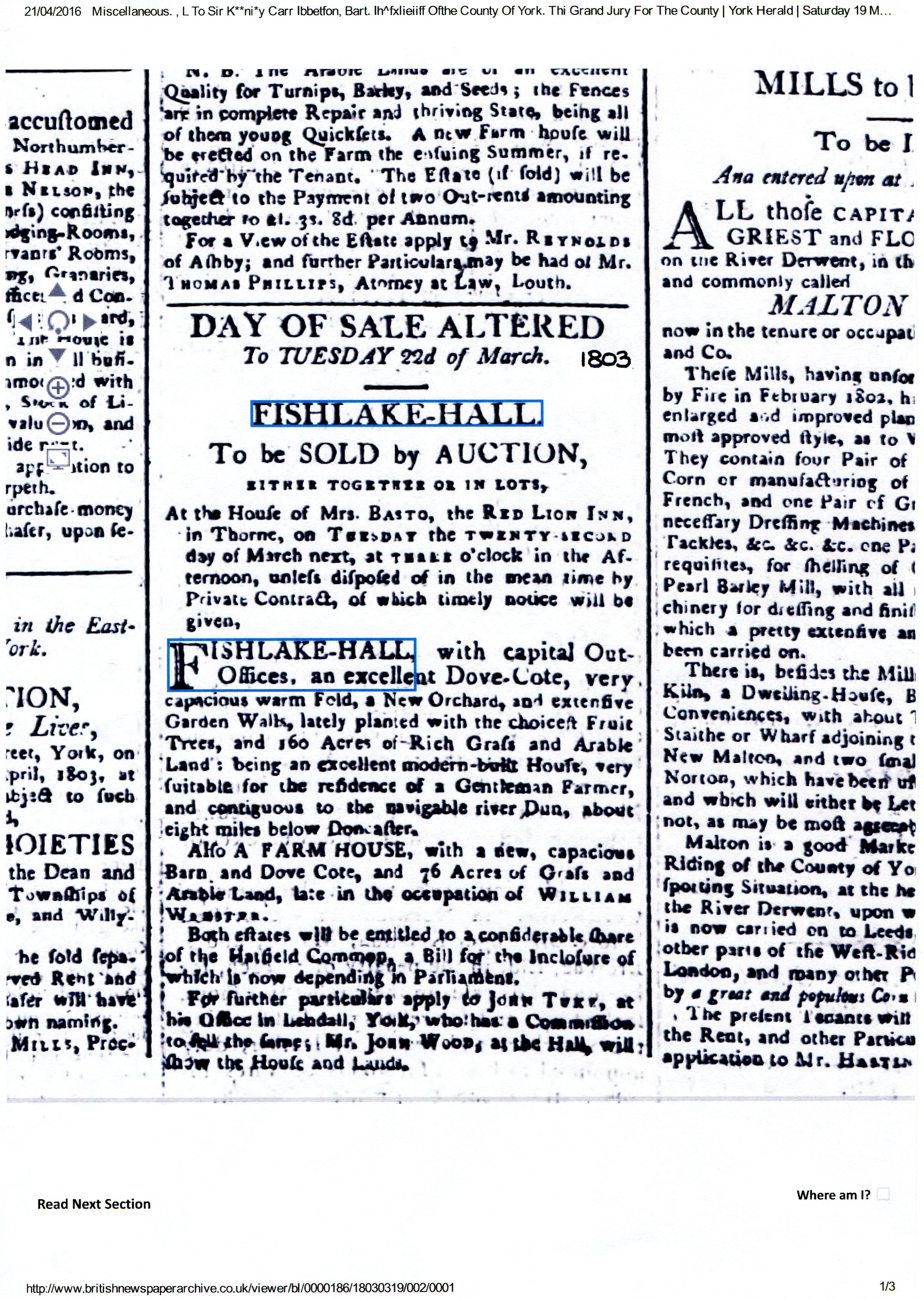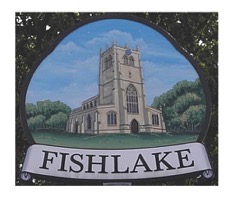
Fishlake Hall (now known as the Hall Farm) is a significant property situated right in the centre of the village occupying a prominent position overlooking the Landing Place and probably the oldest, in its origins, and largest domestic property in the parish.
The archaeology of the site has not been explored due to its current occupation. What limited excavations have been undertaken (e.g. limited pipe installations for drainage) has not uncovered anything noteworthy.
This essay is an attempt for the first time to put into writing what is known about this property and the site.
The properties central and commanding position within the village overall layout and structure is a strong indication that it must have always been of great importance and consequently owned by persons of high social status.
Arial view of Fishlake and Fishlake Hall about 1970.

The oldest physical evidence about the building is a limestone date stone.

The modestly carved heart shaped inscription reads TPS 1610. TPS may well stand for Thomas Perkins' and his wife. The Perkins' were a prominent local family of wealth in the area during 16 th and 17 th century. Until 1974 this stone was located in an outside wall of outbuildings (formally malt kilns) being move to its present position on the front of the property during restoration at that time. I would assume it has now been restored to its original position? It may have been moved when the door way was altered to facilitate a building change in the 19 th century or when there was change of ownership.
Historical Records.
The Hearth Tax of 1674 shows that by far the largest property in Fishlake belonged to Mr Perkins with no less than 10 hearths. This may well refer to the Hall.
Next we have a property inventory of Thomas Perkins dated 26 th May 1692 which given the size and content of this estate could well be Fishlake Hall. It records 14 rooms which includes a brewhouse, dairy and beer buttery. There was a fold, green garth and barn. No mention of a malt kiln or dovecote at this date. A learned man with 2 book cases in the study. See below:

In 1720 a travelling artist, Samuel Buck, made a sketch of Fishlake village entitled "The South W Prospect of Fishlake Village". The drawing clearly shows the Hall in the present position with a dove cote close by (note the doves flying about) and fine gate posts. Above the building is the letter 'S' indicating the home belonged to a Mr Simpson. (The earliest known representation of Fishlake Hall). Elsewhere on the drawing is the rather modest house of Mr Perkins. I would suggest that sometime between 1692 and 1720 that the Hall was sold by the Perkins family to the Simpson's. The Perkins moved out to a small property maybe due to a change in family fortune. S. Buck sketch 1720).

The will of Francis Simpson dated 19 th February 1735 (died 1737) is a detailed account of his estate; He describes his accommodation as " my capital Messuage House wherein I now dwell with ye Mault House Kiln Mill Dovecoat Barns Stables all other Buildings with the foldseads Garden and Orchards and Appurtenances". In his will, he left the property to his wife and then his eldest son the notable Sir Edward Simpson LLD, 1699 –1764 at one time master of Trinity Hall, Cambridge and the Dean of Arches (title of a senior judge). Also, MP for Dover and lived at Acton, Middlesex. Although not born at Fishlake he must have sent his boyhood here as his family were settled in the village by 1706 (his sister was baptised at Fishlake church in 1706). It is highly likely that he attended the Endowed Grammar School before going up to Cambridge in 1718. After his death in 1764 he left all his estate to his wife Elizabeth.

Sir Edward Simpson
(c) Trinity Hall, University of Cambridge; Supplied by The Public Catalogue Foundation
After this time, it became unclear as to who exactly owned or occupied the house as it was not always the same person.

Sale notice.
A sale by auction 22 March 1803 at the Red Lion Inn in Thorne, gives details as follows: "Fishlake Hall with capital Out Offices, excellent Dove Cote, very capacious warm fold, a New Orchard, and extensive Garden Walls, lately planted with the choicest Fruit Trees, and 160 Acres of rich grass and Arable Land: being an excellent modern - built House, very suitable for the residence of a Gentleman Farmer, and contiguous to the navigable river Dunn, about eight miles below Doncaster." Mr John Wood, at the Hall, will show the House and Lands.
January 6 1818 (Hatfield Manor Court Rolls) records the transfer of ownership of Fishlake Hall from Mrs Hannah Howorth to Mr John Oliver and others, the land and property totalling 3a 7p.
In 1825 the Enclosed Award Map shows land at the rear of the property was owned by Hannah Howorth as purchased from William Marshall and David Poole. In 1841 census Robert Edlington and his wife occupied the property but not necessarily owned, as maltster. The present range of building running close to the property were the old malt processing buildings and within living memory the original floor bricks had holes bored through to facilitate the heat drying process. These have now been taken up and used elsewhere. There was also a small fold adjacent now demolished. Ten years later at the 1851 census returns George Hunt aged 54 appears to have owned the Hall as he is described as proprietor of house and land. Again in 1861 he is still living there but now described as a farmer of 22 acres with 1 labourer. By this time, it appears the Hall has been divided into two properties one side being occupied (perhaps rented) to Ann Holbrey the widow of the late Rev William Holbrey, curate of Sykehouse. Then in 1871 she is still occupyed one half of the Hall until her death in 1877.
Thomas Downing junior, the authors great grandfather, purchased the Hall from William Oliver and others for £440 on 15 th February 1871. At that time, he was operating as a cattle dealer with 23 acres of land.
On the death of Thomas Downing junior in 1901 his son Thomas Downing who was then living in Gateshead with his young family working as an insurance agent moved back to Fishlake to take over the estate which I understand was suffering financial difficulties. At his death in 1936 his eldest son Thomas Edward Downing took over the farm. Then on his death in 1957, his daughter Elsie and his husband Douglas Southwell and their family took responsibility for running the farm to the present day.
Other observations about the physical structure.
Despite its originals in the 17 th century, the property as it stands today can be described as 18 th century pan tile and brick dwelling of 2 storey and 3 bays with stone quoins. The frontage brick work is of English Bond style whereas the rear is of Dutch Bond.
There are two wells in the grounds one out of sight near the front of the property next to the kitchen range. The other in the 1970’s was still used as a drain situated in the North-West corner of the old malt house.
At the back of the property lay a large pond of some depth, it was an old brick workings which at some point became flooded and filled in. Under the Hall itself is a large cellar now bordered up which in the past became inundated with water during flooding. Also, a bake oven was uncovered now bricked up.
Two bricked up windows.
The Window Tax operated 1696 and 1851, but the bricking up of these windows most likely occurred during the early 19 th century, to avoid paying window tax. It was introduced in 1696 to raise money for government and sometimes described as a 'tax on light'. It was intended to be a progressive tax in that houses with a smaller number of windows, initially ten, were subject to a 2 shilling house tax but exempt from the window tax. Houses with more than ten windows were liable for additional taxes which increased in line with the number of windows. In 1766 this was extended to houses of seven windows.
Rear view of Hall Farm 1970's.

Revelations during restoration work.
During the restoration in 1974 several artefacts were discovered. An inscription on a pane of glass then part of a sash window in the top and Eastern most end of the house and also inserted with bars on the outer side (possibly a nursery). The glass measured approx 11" x 8", scratched into the inner side of the glass (possibly with diamond ring) is this verse:
To rear the tender thought,
To teach the young idea how to shoot,
To pour the fresh instruction o'er the mind,
To Breath the enlivening spirit and fix,
The generous purpose in the glowing Breast, of charming H: R: Downing
Miss Turner. (this is from a poem by a Scottish poet and play write James Thompson 1700 -1748 called Spring, published in 1728).
Found under some wall paper was a double sheet of paper it is torn out of a copy book and each of the four sides of paper contains four quotations repeated 13 time each,
On the first side, Evil communications corrupt good manners.
On the second side, Fortune and magnanimity commend honoursort,
On the third side, Questions of importance require deliberation.
On fourth side, Reputation is maintained by good action.
Written at the bottom of page one William Fosters' book November 06 1847.
(The first line is from the New Testament).
In summary Fishlake Hall, The Old Hall and currently known as the Hall Farm remains today as an imposing private grade 2 property dominating the central conservation area it the village. Run now as a family farm with a long and fascinating history much of what we do know has been presented in the above article.
Rob Downing 20 June 2017.








